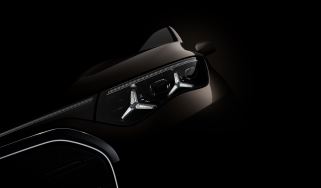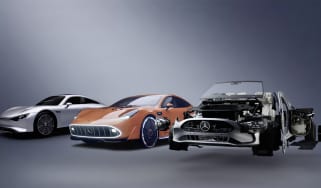Mercedes
New Mercedes S-Class facelift ride review: luxury limo gets some serious upgrades

New Mercedes S-Class facelift ride review: luxury limo gets some serious upgrades
New Mercedes S-Class with big V8 energy is almost here, and we’ve been for a ride in it
New electric Mercedes S-Class will replace the EQS… eventually

New electric Mercedes S-Class will replace the EQS… eventually
The next iteration of the S-Class will give its affluent customers the choice of combustion or electric power
Best new cars coming soon: all the big new car launches due in 2026, 2027 and beyond

Best new cars coming soon: all the big new car launches due in 2026, 2027 and beyond
Here are the most important new cars from Audi, BMW, Dacia, Ferrari, Ford, Skoda and more that you need to know about
Best estate cars to buy 2026

Best estate cars to buy 2026
A good estate car delivers practicality and low running costs - here are the 10 best estates on sale in the UK today
Best convertible cars and cabriolets to buy 2026

Best convertible cars and cabriolets to buy 2026
Love the feeling of the wind in your hair while driving? These are the cars for you
Mercedes VLE to arrive 10 March with all-new VAN.EA technology 

Mercedes VLE to arrive 10 March with all-new VAN.EA technology
Mercedes is taking the luxury MPV segment seriously
Mercedes XX Tomorrow outlines brand’s sustainable future

Mercedes XX Tomorrow outlines brand’s sustainable future
New Mercedes programs will reduce waste, cost and emissions through over 40 measures
New Mercedes GLB revealed for 2026: 7-seater gains in space and versatility, if not design

New Mercedes GLB revealed for 2026: 7-seater gains in space and versatility, if not design
The second-generation Mercedes GLB will be launched in 2026, with a choice of hybrid or pure-electric power
Used Car Hunter: automatic diesel premium saloons for £12,000

Used Car Hunter: automatic diesel premium saloons for £12,000
Our Car Hunter has a budget of £12,000 to spend on a premium-badged family saloon
Mercedes G-Class Cabriolet set for long-awaited return and it’s a four-door!

Mercedes G-Class Cabriolet set for long-awaited return and it’s a four-door!
This could be the ideal 4x4 for the mean streets of Kensington, the Mercedes G-Glass convertible is back
New Mercedes GLC facelift spotted: design and tech upgrades due in 2026

New Mercedes GLC facelift spotted: design and tech upgrades due in 2026
The mid-size Mercedes SUV could be set for new technology and powertrains in 2026
Svelte new Mercedes CLA Shooting Brake on sale now with 469-mile range

Svelte new Mercedes CLA Shooting Brake on sale now with 469-mile range
The CLA Shooting Brake trades a bit of range compared to the saloon but adds a healthy dose of practicality
Best saloon cars to buy in 2026

Best saloon cars to buy in 2026
Saloon cars may be less popular than they used to be, but there are still plenty of fantastic models to choose from
Baby Mercedes G-Class spotted testing as ‘Little G’ EV preps for 2027 launch

Baby Mercedes G-Class spotted testing as ‘Little G’ EV preps for 2027 launch
£150,000 electric G-Class too expensive? Check out Mercedes’ upcoming miniature retro EV
New Brabus XL 800 Cabrio is an open-air off-roader at a jaw-dropping price

New Brabus XL 800 Cabrio is an open-air off-roader at a jaw-dropping price
Based on the current Mercedes-AMG G 63, bonkers 800bhp Brabus gets ‘Masterpiece’ interior and rear soft-top
Tesla Model 3 vs Mercedes CLA: which EV is the elite executive car?

Tesla Model 3 vs Mercedes CLA: which EV is the elite executive car?
On paper, Mercedes’ CLA Mk2 looks set to deliver the goods in the electric company-car sector. Has the big-selling Tesla Model 3 finally met its match…
Best used convertibles to buy 2026

Best used convertibles to buy 2026
If it’s open-top thrills that you’re after, the best used convertibles offer incredible value for money
Best used sports cars to buy 2025

Best used sports cars to buy 2025
Looking for a fun but sensibly-priced set of wheels? These are the best used sports cars to buy right now
Best used large SUVs and 4x4s to buy 2026

Best used large SUVs and 4x4s to buy 2026
The best used large SUVs and 4x4s offer space, practicality, performance and low running costs
Best used luxury cars to buy 2026

Best used luxury cars to buy 2026
An ultra-comfortable ride and a premium driving experience can be yours with the best used luxury cars
Best used coupes to buy 2026

Best used coupes to buy 2026
If you want an appealing car that mixes performance with style, these used coupes will tick a lot of boxes
Best used executive cars to buy 2026

Best used executive cars to buy 2026
If you need a fast, comfortable and stylish set of wheels, these are the best used executive cars that the market has to offer
Used Mercedes G-Class (Mk2, 2018-2024) buyer’s guide: tough SUV is expensive to buy and run

Used Mercedes G-Class (Mk2, 2018-2024) buyer’s guide: tough SUV is expensive to buy and run
A full used buyer’s guide on the Mercedes G-Class, covering the G-Class Mk2 that was on sale between 2018 and 2024
Best luxury electric cars 2026

Best luxury electric cars 2026
With their quiet, powerful performance, electric cars are well suited to delivering a high level of luxury, these are the pick of the current crop…
New Mercedes GLC with EQ Technology prototype review: the perfect EV to fight back against BMW

New Mercedes GLC with EQ Technology prototype review: the perfect EV to fight back against BMW
The all-electric Mercedes GLC with EQ Technology could be the car to tame the BMW iX3
New Mercedes CLA hybrid launched: 3 power options, 5 specs and up to 56mpg

New Mercedes CLA hybrid launched: 3 power options, 5 specs and up to 56mpg
Hybrid CLA joins the EV in small saloon range, and comes with a wide range of engine and spec options
Best long-distance cars 2026

Best long-distance cars 2026
From long-distance road trips to mile-munching motorway commutes, these are the best long distance cars money can buy
Best electric car deals: today's top discounts and incentives on new EVs

Best electric car deals: today's top discounts and incentives on new EVs
Making the switch to an EV? These car brands have an offer (or two) for you
Electrifying stuff! All-new electric Mercedes E-Class spotted for the first time

Electrifying stuff! All-new electric Mercedes E-Class spotted for the first time
The replacement for the Mercedes EQE electric saloon will wear the more familiar E-Class name, and will clearly have a more traditional look
Next-gen Mercedes Sprinter is ready to rock... literally 

Next-gen Mercedes Sprinter is ready to rock... literally
A brand-new platform will cater to both combustion-engined and all-electric Sprinters
All-electric Mercedes GLC goes on sale from £60,350 with 400-mile range and massive screen

All-electric Mercedes GLC goes on sale from £60,350 with 400-mile range and massive screen
The new GLC with EQ Technology replaces the EQC with a much longer range



